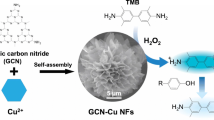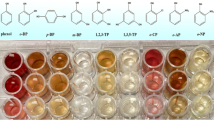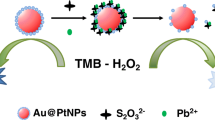Abstract
In this study, 3,3′,5,5′-tetramethylbenzidine (TMB) was selected as a chromogenic substrate to evaluate the light-responsive oxidase-like activity of different zeolitic imidazolate frameworks (ZIFs). The synthesized ZIFs were systematically characterized by scanning electron microscopy, transmission electron microscopy, Fourier transform infrared spectroscopy, and X-ray diffraction analysis. Several main operational parameters, including ZIFs and TMB concentrations, pH value, radiation time, and working current, in the reaction process were optimized. The kinetic measurement results show that ZIF-90 exhibits higher affinity to the substrate than horseradish peroxidase. Furthermore, given that adenosine triphosphate (ATP) can specifically combine with Zn2+ binding site and destroy the structure of ZIF-90, a specific and sensitive colorimetric method was established for the quantitative detection of ATP within the range 10 − 240 μM. In addition, on the basis that phenolic pollutants can impact the reaction kinetics diversely on different ZIFs, a sensor array was constructed and successfully applied to differentiate five phenolic pollutants in lake water samples. This work is expected to shed light on the establishment of ZIF-based light-responsive oxidase-like nanozymes for the highly selective colorimetric detection and sensor array.
Graphical Abstract






Similar content being viewed by others
Data Availability
The data that support the findings of this study are available from the corresponding author upon reasonable request.
References
Huang Y-Y, Mu X-Y, Wang J-Y, Wang Y, Xie J, Ying R-F, Su E (2022) The recent development of nanozymes for food quality and safety detection. J Mater Chem B 10(27):1359–1368. https://doi.org/10.1039/d2tb90092k
Ai Y-J, Hu Z-N, Liang X-P, Sun H-B, Xin H-B, Liang Q-L (2021) Recent advances in nanozymes: from matters to bioapplications. Adv Funct Mater 32(14):2110432. https://doi.org/10.1002/adfm.202110432
Gao L-Z, Zhuang J, Nie L, Zhang J-B, Zhang Y, Gu N, Wang T-H, Feng J, Yang D-L, Perrett S, Yan X (2007) Intrinsic peroxidase-like activity of ferromagnetic nanoparticles. Nat Nanotechnol 2(9):577–583. https://doi.org/10.1038/nnano.2007.260
Zhang X-J, Lin S-J, Liu S-W, Tan X-L, Dai Y, Xia F (2021) Advances in organometallic/organic nanozymes and their applications. Coord Chem Rev 429:213652. https://doi.org/10.1016/j.ccr.2020.213652
Chen Y-F, Zhang Y, Jiao L, Yan H-Y, Gu W-L, Zhu C-Z (2021) Research progress of carbon-based nanozymes for biosensing. Chin J Anal Chem 49(6):907–921. https://doi.org/10.19756/j.issn.0253-3820.211258
Li S-Q, Liu X-D, Chai H-X, Huang Y-M (2018) Recent advances in the construction and analytical applications of metal-organic frameworks-based nanozymes. Trac-Trends Anal Chem 105:391–403. https://doi.org/10.1016/j.trac.2018.06.001
Wang X-Y, Gao X-J, Qin L, Wang C-D, Song L, Zhou Y-N, Zhu G, Cao W, Lin S-C, Zhou L-Q, Wang K, Zhang H, Jin Z, Wang P, Gao X, Wei H (2019) e(g) occupancy as an effective descriptor for the catalytic activity of perovskite oxide-based peroxidase mimics. Nat Commun 10:704. https://doi.org/10.1038/s41467-019-08657-5
Zhao H-Q, Zhang R-F, Yan X-Y, Fan K-L (2021) Superoxide dismutase nanozymes: an emerging star for anti-oxidation. J Mater Chem B 9(35):6939–6957. https://doi.org/10.1039/d1tb00720c
Chong Y, Liu Q, Ge C-C (2021) Advances in oxidase-mimicking nanozymes: classification, activity regulation and biomedical applications. Nano Today 37:101076. https://doi.org/10.1016/j.nantod.2021.101076
Walther R, van den Akker W, Fruergaard A-S, Zelikin A-N (2020) Nanozymes and glucuronides: glucuronidase, esterase, and/or transferase activity. Small 16(44):e2004280. https://doi.org/10.1002/smll.202004280
Zhang X-J, Lin S-J, Wang Y-C, Xia F, Dai Y (2021) Cofactor-free organic nanozyme with assembly-induced catalysis and light-regulated activity. Chem Eng J 426:130855. https://doi.org/10.1016/j.cej.2021.130855
Ni P-J, Liu S-Y, Wang B, Chen C-X, Jiang Y-Y, Zhang C-H, Chen J-B, Lu Y-Z (2021) Light-responsive Au nanoclusters with oxidase-like activity for fluorescent detection of total antioxidant capacity. J Hazard Mater 411:125106. https://doi.org/10.1016/j.jhazmat.2021.125106
Zhao J, Wang H-H, Geng H-Q, Yang Q, Tong Y, He W-W (2021) Au/N-doped carbon dot nanozymes as light-controlled anti- and pro-oxidants. ACS Appl Nano Mater 4(7):7253–7263. https://doi.org/10.1021/acsanm.1c01215
Huang L-J, Chen K, Zhang W-T, Zhu W-X, Liu X-N, Wang J, Wang R, Hu N, Suo Y-R, Wang J-L (2018) ssDNA-tailorable oxidase-mimicking activity of spinel MnCo2O4 for sensitive biomolecular detection in food sample. Sens Actuator B-Chem 269:79–87. https://doi.org/10.1016/j.snb.2018.04.150
Liu Y-F, Wang X-Y, Wang Q, Zhang Y-H, Liu Q-Y, Liu S-J, Li S-R, Du Y, Wei H (2021) Structurally engineered light-responsive nanozymes for enhanced substrate specificity. Anal Chem 93(45):15150–15158. https://doi.org/10.1021/acs.analchem.1c03610
Yuan M-Y, Xiao S-J, Wu Y-N, Qiu A-T, Guo J, Zhong Z-Q, Zhang L (2022) Visual detection of captopril based on the light activated oxidase-mimic activity of covalent organic framework. Microchem J 175:107080. https://doi.org/10.1016/j.microc.2021.107080
Gross A-F, Sherman E, Vajo J-J (2012) Aqueous room temperature synthesis of cobalt and zinc sodalite zeolitic imidizolate frameworks. Dalton Trans 41(18):5458–5460. https://doi.org/10.1039/c2dt30174a
Wu R-B, Qian X-K, Rui X-H, Liu H, Yadian B-L, Zhou K, Wei J, Yan Q-Y, Feng X-Q, Long Y, Wang L, Huang Y (2014) Zeolitic imidazolate framework 67-derived high symmetric porous Co3O4 hollow dodecahedra with highly enhanced lithium storage capability. Small 10(10):1932–1938. https://doi.org/10.1002/smll.201303520
Chaikittisilp W, Hu M, Wang H, Huang H-S, Fujita T, Wu K-C, Chen L-C, Yamauchi Y, Ariga K (2012) Nanoporous carbons through direct carbonization of a zeolitic imidazolate framework for supercapacitor electrodes. Chem Commun (Camb) 48(58):7259–7261. https://doi.org/10.1039/c2cc33433j
Wang Y-W, Zhang D, Zeng Y, Qi P (2021) Selective ATP detection via activation of MoS2-based artificial nanozymes inhibited by ZIF-90 nanoparticles. ACS Appl Nano Mater 4(11):11545–11553. https://doi.org/10.1021/acsanm.1c01986
Zou Y-L, Liu X-Y, Zhang H-X (2021) A dual enzyme-containing microreactor for consecutive digestion based on hydrophilic ZIF-90 with size-selective sheltering. Colloid Surf B-Biointerfaces 197:111422. https://doi.org/10.1016/j.colsurfb.2020.111422
Zheng L-Z, Kang X-W, Ji Y, Zou Z-J, Wang Y-M, Chen J-F (2015) Preparation of Ag/ZIF-90 self-assembled membrane and its high SERS performance. Chin J Inorg Chem 31(3):465–471
Dong H-J, Fan Y-Y, Zhang W, Gu N, Zhang Y (2019) Catalytic mechanisms of nanozymes and their applications in biomedicine. Bioconjug Chem 30(5):1273–1296. https://doi.org/10.1021/acs.bioconjchem.9b00171
Cheng Q, Yang Y, Peng Y-S, Liu M (2020) Pt nanoparticles with high cxidase-like activity and reusability for detection of ascorbic acid. Nanomaterials (Basel) 10(6):1015. https://doi.org/10.3390/nano10061015
Ci Y-X, Chen L, Wei S (1988) Peroxidase-catalysed fluorescence reaction using tyrosine as substrate. Fresenius Zeitschrift Fur Analytische Chemie 332(3):258–260. https://doi.org/10.1007/BF00492972
Li S, Zhao X-T, Yu X-X, Wan Y-Q, Yin M-Y, Zhang W-W, Cao B-Q, Wang H (2019) Fe3O4 nanozymes with aptamer-runed catalysis for selective colorimetric analysis of ATP in blood. Anal Chem 91(22):14737–14742. https://doi.org/10.1021/acs.analchem.9b04116
Zhang W, Wang C, Peng M-H, Ren G-Y, Li K, Lin Y-Q (2020) ATP-responsive laccase@ZIF-90 as a signal amplification platform to achieve indirect highly sensitive online detection of ATP in rat brain. Chem Commun (Camb) 56(47):6436–6439. https://doi.org/10.1039/d0cc02021d
Xie H, Chai Y, Yuan Y, Yuan R (2017) Highly effective molecule converting strategy based on enzyme-free dual recycling amplification for ultrasensitive electrochemical detection of ATP. Chem Commun (Camb) 53:8368–8371. https://doi.org/10.1039/c7cc03497k
Kashefi-Kheyrabadi L, Mehrgardi M-A (2012) Aptamer-conjugated silver nanoparticles for electrochemical detection of adenosine triphosphate. Biosens Bioelectron 37:94–98. https://doi.org/10.1016/j.bios.2012.04.045
Huang Y-F, Chang H-T (2007) Analysis of adenosine triphosphate and glutathione through gold nanoparticles assisted laser desorption/ionization mass spectrometry. Anal Chem 79:4852–4859. https://doi.org/10.1021/ac070023x
Li S, Zhao X, Yu X, Wan Y, Yin M, Zhang W, Cao B, Wang H (2019) Fe3O4 nanozymes with aptamer-tuned catalysis for selective colorimetric analysis of ATP in blood. Anal Chem 91:14737–14742. https://doi.org/10.1021/acs.analchem.9b04116
Cheng S, Zheng B, Wang M, Lam M-H, Ge X (2013) Double-functionalized gold nanoparticles with split aptamer for the detection of adenosine triphosphate. Talanta 115:506–511. https://doi.org/10.1016/j.talanta.2013.05.065
Sancenón F, Descalzo A-B, Martínez-Máñez R, Miranda M-A, Soto J (2001) A colorimetric ATP sensor based on 1,3,5-Triarylpent-2-en-1,5-diones. Angew Chem Int Ed Engl 40:2640–2643. https://doi.org/10.1002/1521-3773(20010716)40:14%3c2640::AID-ANIE2640%3e3.0.CO;2-A
Zhang Y-M, Song J, Shao W-H, Li J (2021) Au@NH2-MIL-125(Ti) heterostructure as light-responsive oxidase-like mimic for colorimetric sensing of cysteine. Microporous Mesoporous Mat 310:110642. https://doi.org/10.1016/j.micromeso.2020.110642
Abdelhameed R-M, Tobaldi D-M, Karmaoui M (2018) Engineering highly effective and stable nanocomposite photocatalyst based on NH2-MIL-125 encirclement with Ag3PO4 nanoparticles. J Photochem Photobiol A-Chem 351:50–58. https://doi.org/10.1016/j.jphotochem.2017.10.011
Barrios-Estrada C, de Jesús R-A, Muñoz-Gutiérrez B-D, Iqbal H-M-N, Kannan S, Parra-Saldívar R (2018) Emergent contaminants: endocrine disruptors and their laccase-assisted degradation-a review. Sci Total Environ 612:1516–1531. https://doi.org/10.1016/j.scitotenv.2017.09.013
Khatoon N, Jamal A, Ali M-I (2017) Polymeric pollutant biodegradation through microbial oxidoreductase: a better strategy to safe environment. Int J Biol Macromol 105:9–16. https://doi.org/10.1016/j.ijbiomac.2017.06.047
Acknowledgements
This work was supported by the National Key Research and Development Program of China (No. 2021YFC2103300).
Author information
Authors and Affiliations
Contributions
Shi-Jun Yin: conceptualization, methodology, investigation, and writing-original draft. Guo-Ying Chen: investigation. Chun-Yan Zhang: investigation. Jia-Li Wang: investigation. Feng-Qing Yang: supervision, project administration, funding acquisition, and writing—review and editing.
Corresponding author
Ethics declarations
Institutional review board statement
Rabbit plasma used in this study were purchased from Shanghai YuanYe Biological Technology Co., Ltd., China, which are biological products, thus not applicable to Ethics statement.
Conflict of interest
The authors declare no competing interests.
Additional information
Publisher's note
Springer Nature remains neutral with regard to jurisdictional claims in published maps and institutional affiliations.
Supplementary Information
Below is the link to the electronic supplementary material.
Rights and permissions
Springer Nature or its licensor (e.g. a society or other partner) holds exclusive rights to this article under a publishing agreement with the author(s) or other rightsholder(s); author self-archiving of the accepted manuscript version of this article is solely governed by the terms of such publishing agreement and applicable law.
About this article
Cite this article
Yin, SJ., Chen, GY., Zhang, CY. et al. Zeolitic imidazolate frameworks as light-responsive oxidase-like mimics for the determination of adenosine triphosphate and discrimination of phenolic pollutants. Microchim Acta 190, 25 (2023). https://doi.org/10.1007/s00604-022-05602-0
Received:
Accepted:
Published:
DOI: https://doi.org/10.1007/s00604-022-05602-0




